They run the checkpoints and their presence is clearly visible in cities. After the regular army, civilians of the Ukrainian Territorial Defense Force are the last shield against the Russians.
At 20 years old, “Buffalo” is 2.07 meters tall and weighs about 100 kilos. Since the beginning of the invasion of Russia, he quit his job in construction and joined this force, equivalent to a military reserve.
Like hundreds of thousands of Ukrainian civilians, he responded to the call of President Volodymir Zelensky who decreed a general mobilization.
“Buffalo”, given only its pseudonym, was assigned to the sector of Svyatohirsk, a village about thirty kilometers north of Kramatorsk, the de facto capital of the Ukrainian-controlled Donbas, in the east of the country.
The front lines extend about ten kilometers to the north and northwest, particularly around the town of Izium, where the battle rages. This city is the deadbolt that opens the way to Kramatorsk.
From that area comes every day the noise of the bombing. “I'm sure you can hear the artillery and how our peoples are disappearing from the face of the earth,” “Buffalo” tells AFP, wearing a camouflage suit and a balaclava that only allows you to see their eyes.
On his phone he shows the video where he is seen in the snow, kalashnikov in hand and in combat position with his teammates. But its mission is also to protect and help the inhabitants.
“Civilians know what war is. They stay in the basements and it's the least they can do to save their lives. Whenever we can, we bring them food and water. There are many older people who have nowhere to go,” he says.
A bridge with the population
There are still many neighbors in the village of Svyatohirsk, with about 5,000 inhabitants before the war, and known for its Orthodox monastery of the “Holy Mountain”.
Work accumulates for Andriy on the counter of his small café-restaurant. Locals, military, and members of the Defense Forces line up for a hot dog, hamburger or hot drink.
“Some people have left and others have stayed. People are here. Everyone walks, shops, they have to eat one way or another,” says the merchant.
With the Kalashnikov in a shoulder bag, in a camouflage suit and a khaki hat on his head, the 39-year-old says that the Territorial Defense Force “is a very important bridge with civilians, (because) it is made up of civilians”.
“I think it's unique,” he says.
“We have people of different ages and different horizons who have gathered everything because we have only one goal. Teachers, engineers, workers, artists, this is extremely important”, considers this man, a former official.
“We will hold out until the last breath,” he says.
Numerous bridges have been destroyed in the region to obstruct the advance of Russian forces, in the face of fear of a major offensive in this region of the Donbas.
The one in Svyatohirsk is still standing, but the mines are already in place to blow it up. Until now guarded by members of the territorial force, their vigilance now depends on the regular army.
“At the same time, the bridge is under the protection of the Ukrainian armed forces and the territorial defense,” says Volodymir Rybalkin, a journalist in civilian life and now head of this body in the town.
Like many members of these civilian troops, he was trained in the fighting during the Donbas war, between 2014 and 2015.
“Above us are professional military commandos, which coordinate. Our task is to communicate with civilians so that there is understanding and support between them,” he explains.
Asked about the planned Russian offensive, the man is confident.
“The front line is less than 10 kilometers away. The artillery works at full power and drives away the enemy. I can't predict what will happen tomorrow. Today the (Russian) planes have not flown, we don't know if they will be back tomorrow. We will react to all his actions,” he says.
Behind him, “Buffalo” sings a refrain directed with contempt at Russian President Vladimir Putin.
“Glory to Ukraine!” , shouts when finished. “Glory to heroes!” , their comrades respond in chorus.
(With information from AFP/by Emmanuel Peuchot)
KEEP READING:
Últimas Noticias
Debanhi Escobar: they secured the motel where she was found lifeless in a cistern

The oldest person in the world died at the age of 119

Macabre find in CDMX: they left a body bagged and tied in a taxi
The eagles of America will face Manchester City in a duel of legends. Here are the details

Why is it good to bring dogs out to know the world when they are puppies




